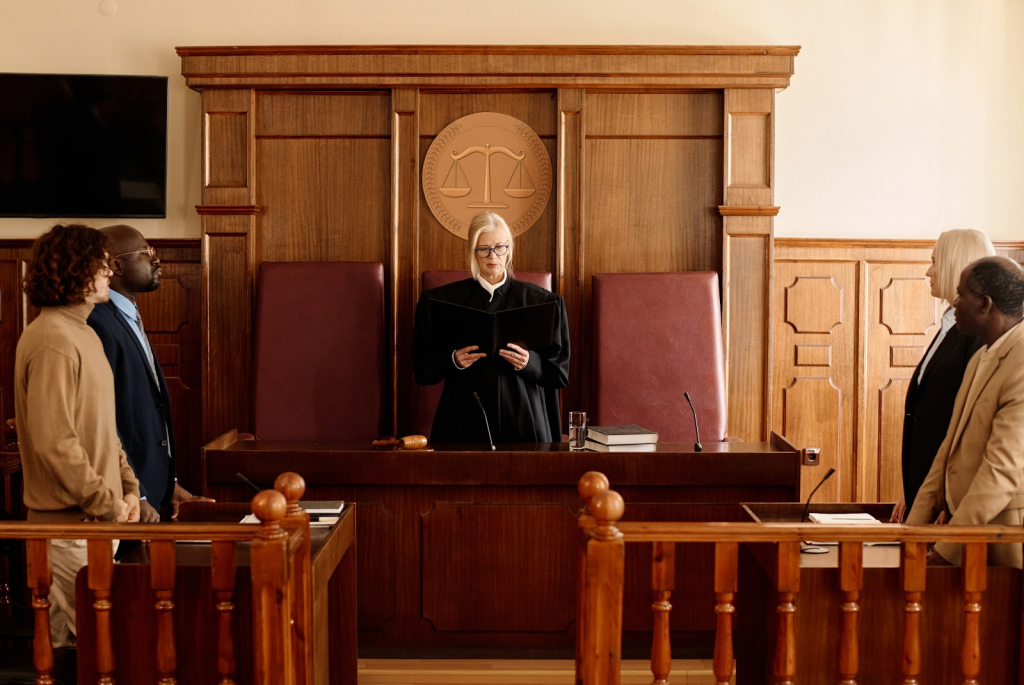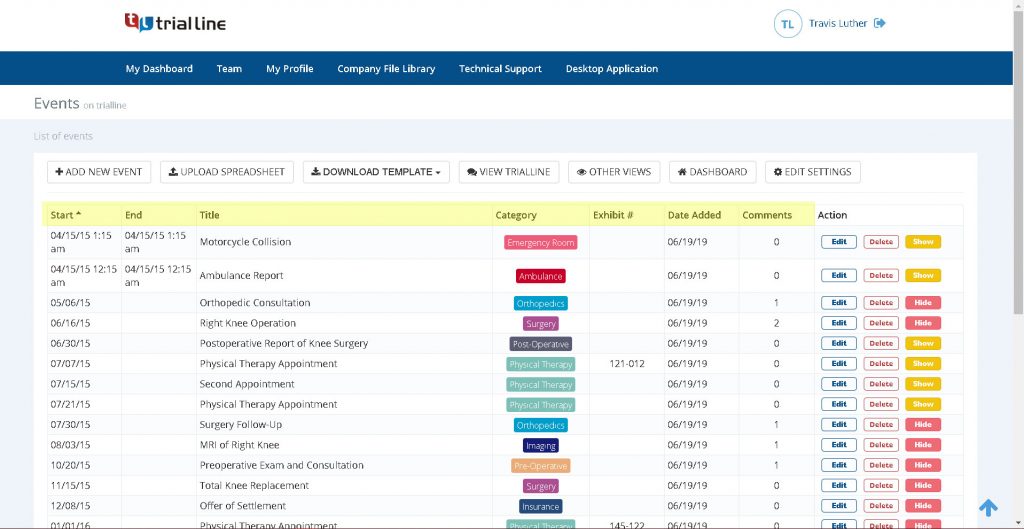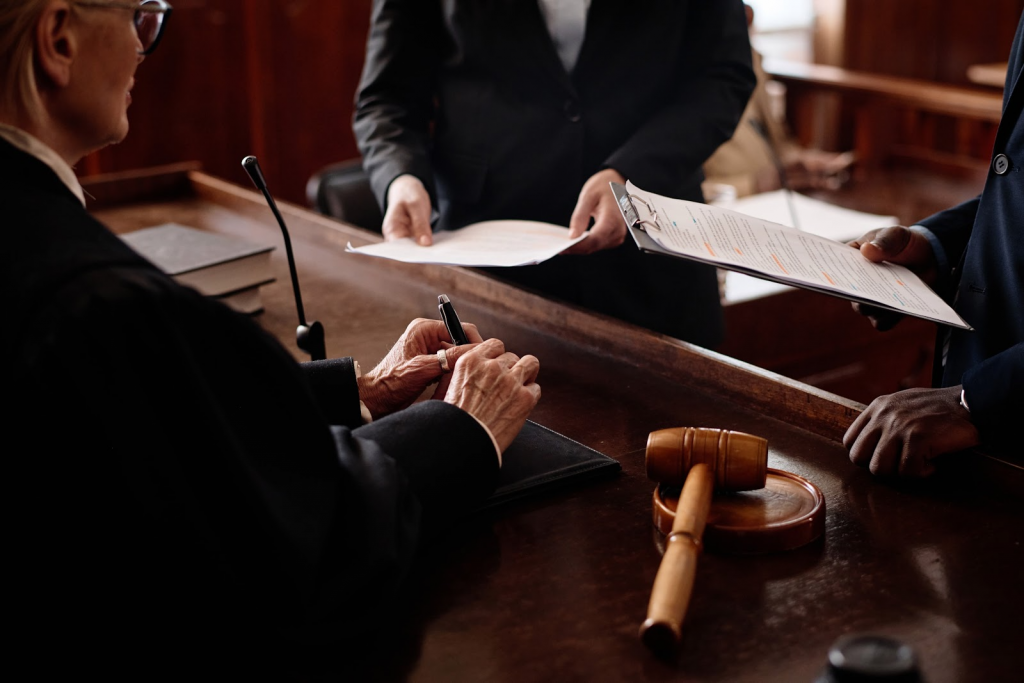Every appellant must follow strict time limits when filing appeals, submitting post-judgment motions, and responding to other party filings. Missing a deadline can cause delays or even lead to dismissal.
A well-organized case chronology helps track key dates, document necessary evidence, and strengthen legal arguments. Proper structuring ensures compliance with the court of appeals’ rules and increases the chances of a favorable ruling.
To maintain an efficient appeal timeline, legal professionals should use visual and technological tools to manage deadlines, track filings, and structure legal arguments effectively.
This guide explains how to manage the appeal period, the importance of a clear case timeline, and strategies for optimizing chronology.
Organize Case Chronology with Precision. Start Your Free Trial of TrialLine!
Breakdown of the Appeal Timeline
The appeal timeline follows a structured process that dictates when each step must be completed.
Understanding these deadlines is necessary for any appellant looking to challenge a court decision successfully. The appeal process typically involves filing a defendant’s notice, submitting legal briefs, and sometimes presenting oral arguments.
Each stage has a time limit, and failure to comply can result in case dismissal. The timeline varies depending on whether the case is in a district court, the court of appeals, or the Supreme Court.
Deadlines can be affected by factors such as newly discovered evidence, post-judgment motions, or a district judge granting an extension to the appeal time.
Certain motions listed in Rule 4(a)(4) also pause the appeal period. However, a motion for attorney’s fees does not extend the deadline unless the district court extends it under Rule 58(e). Filing such a motion will not delay other deadlines unless ordered by the judge.
Below are the appeal process stages and their respective time limits.
Initiating the Appeal Process
The appeal process begins when the appellant files a notice of appeal within the designated appeal period. The exact deadline depends on whether it is a civil case or a criminal case:
- Civil case: The appeal must be filed within 30 days of the final judgment unless a statute provides otherwise.
- Criminal case: The defendant’s notice must be filed within 14 days of the judgment or sentencing.
If post-trial or post-judgment motions are pending, such as a motion filed for a new trial or a request for reconsideration, the appeal period may be paused until those motions are resolved.
The court will issue an order disposing of these motions, which resets the deadline for an appeal filed afterward.
In some cases, if the district court extends the deadline due to excusable neglect or other valid reasons, additional time may be granted for the appeal to be filed. However, these extensions are limited and granted only in specific circumstances.
Written Briefs and Oral Arguments
Once the notice of appeal is submitted, both parties must file legal briefs outlining their arguments.
These documents form the backbone of the appeal process, presenting the legal basis for challenging or defending the court decision.
- Opening brief (appellant): The appellant submits an opening brief explaining why the judgment should be reversed. This must be filed within a set time period, typically 40 days after the notice is filed.
- Counter-brief (appellee): The other party, known as the appellee, has the opportunity to respond with a counter-brief, often within 30 days.
- Reply brief (appellant): The appellant may then submit a reply brief, addressing the arguments presented by the other party.
Some appellate courts decide cases solely on these written arguments, while others allow oral arguments.
If scheduled, oral arguments are usually brief, with attorneys given 10–30 minutes to present their case before a panel of judges.
Reversal and Appellate Review
During the appellate review, the court of appeals examines the record from the district court to determine if legal errors were made.
Unlike a trial, no new evidence or witness testimony is introduced. Instead, the judges determine if mistakes in the proceeding impacted the judgment and require a change.
The possible outcomes of an appellate review include:
- Reversal of judgment: If the court of appeals identifies a legal error that influenced the case, the judgment may be reversed.
- Harmless error ruling: If the error was minor and did not affect the case outcome, the judgment constitutes a harmless mistake, and the original ruling will stand.
- Further legal action: A reversal can result in a new trial, modification of the judgment, and another legal remedy ordered by the court of appeals.
However, not all cases qualify for a new appeal, especially if the errors were not raised in the initial trial.
For a reversal to occur, the appellant must show that the mistake had a direct and meaningful effect on the case outcome.
The Court’s Decision
After reviewing the record, the court of appeals issues a ruling that can:
- Affirm: The court upholds the lower ruling with no changes.
- Reverse: The decision is overturned, potentially leading to a new trial or a different outcome.
- Remand: The case is sent back to the district court for further proceedings.
A party may file a petition for rehearing or seek Supreme Court review. An important exception applies if a party does not receive notice of the decision, in which case an extension may be granted.
To obtain review by the Supreme Court, a certiorari petition must be filed within 90 days of the appellate ruling or rehearing denial.
How a Court Case Timeline Strengthens Your Appeal Strategy
Courts rely on precise documentation, and without a properly maintained record, an appellant may struggle to prove procedural errors or justify the need for a new trial.
An effective case chronology allows attorneys to:
Support the Underlying Arguments
Case chronology strengthens the appeal by aligning legal arguments with documented events.
The court of appeals reviews if procedural and legal errors occurred, and an organized timeline can help demonstrate:
- Procedural fairness: A clear sequence of filings and rulings helps show that all parties followed proper legal procedures.
- Grounds for appeal: A timeline highlights events that justify an appeal filed based on judicial errors, misinterpretation of laws, or procedural missteps.
- Timely motion: The court may reject an appeal if it is not filed within the designated appeal period. An accurate timeline makes sure all motions and responses comply with required time limits.
Without a well-documented case timeline, an appellant risks losing an appeal due to incomplete or disorganized arguments.
Sign Up for a Free 7-Day Trial of TrialLine—Build Better Timelines for Your Appeal!
Smoothly Integrate Legal Points
A strong appeal relies on linking events to relevant laws and procedural rules. By structuring a timeline, lawyers can show how specific errors in the trial impacted the outcome. For example:
- Wrongly admitted evidence may have influenced the jury’s decision.
- A motion filed for reconsideration might have been ignored, affecting the appeal period.
- The district judge may have issued an incorrect ruling, which can be challenged.
By aligning events with legal arguments, attorneys make it easier for the court of appeals to understand why the judgment should be reversed or why a new trial is necessary.
Show Case Overview and Key Facts
An effective case chronology provides a clear, structured overview of key trial events, helping the court of appeals evaluate the appeal’s merit.
The more precise the timeline, the easier it is to demonstrate legal errors and justify the need for a new appeal. A clear timeline should include:
- Key dates of the trial, motions, and judgment issuance.
- Significant court decisions affecting the case outcome.
- The filed appeal and subsequent legal steps taken.
- Any newly discovered evidence that could impact the appeal process.
Presenting information in a structured format helps the court of appeals review the case record and identify relevant legal issues.
Best Ways to Have a Well-Structured Case Timeline
To present a strong case before the court of appeals, legal professionals must make sure every event is documented in a structured format.
The following methods can help create a well-structured case timeline, improving the clarity and effectiveness of an appeal.
Get Visual and Technological Tools
Modern legal timeline software provides a structured format for tracking appeal-related deadlines, documents, and court rulings.
These tools offer features such as annotations, document links, and chronological filtering, making case details easier to review.
Benefits of using timeline software in appeals:
- Highlights key events visually: Judges can quickly review the most relevant case details.
- Tracks separate documents and deadlines: Makes sure the judgment constitutes a final ruling before appeal deadlines are triggered.
- Improve clarity: Organize motion filings, rulings, and appeals in a structured, easy-to-follow format.
Book a demo with TrialLine—No commitment, just smarter case management!
Use a Timeline Template
Using a timeline template provides a structured format for documenting case details.
A standardized format ensures that all relevant case events are presented in a logical sequence, making it easier for the court of appeals to follow the appeal.
Key elements of a timeline template include:
- Case milestones: Adding important events such as the defendant’s notice, post-trial motions, and court rulings.
- Filing deadlines: Making sure every appeal is filed within the designated time period to comply with appeal time regulations.
- Legal arguments: Linking specific claims to relevant statutes, precedents, or procedural rules.
- Supporting documents: Attaching necessary evidence, such as transcripts, rulings, and legal briefs, in an organized manner.
With a properly formatted case chronology, attorneys can provide a detailed and professional presentation of case facts, improving the clarity and effectiveness of an appeal.
Presenting a Clear Case History for Appellate Success With TrialLine

Managing an appeal timeline requires tracking court filings, deadlines, and procedural events. Without a clear system, important dates may be missed, weakening the appeal.
TrialLine is legal timeline software designed to provide a structured way to document motions filed, legal arguments, and procedural actions, ensuring compliance with time limits.
With TrialLine, attorneys can organize events, attach key evidence, track deadlines, and highlight procedural errors. The court of appeals relies on written records, making a clear timeline essential for a strong appeal.
Legal professionals can simplify documentation, enhance clarity, and improve their appeal strategy by using TrialLine.
Organize, Present, and Win. Start Using TrialLine for Free Today!
FAQs About Appeal Timeline
How long do most appeals take?
Most appeals take several months to over a year, though complex cases can take even longer. The timeline depends on factors such as the court’s schedule, the volume of pending cases, and whether procedural delays—such as requests for extensions or additional motions—are filed. Appeals in higher courts, such as federal appellate courts, often take longer than those in state courts. Expedited appeals may be available in some cases, such as those involving constitutional issues, child custody, or urgent matters.
What is the timeline for the appeal brief?
The timeline for an appeal brief varies by jurisdiction but generally follows this structure. The appellant’s brief (the initial argument) is usually due 30 to 60 days after filing the notice of appeal. The appellee’s response brief is typically due 30 days after receiving the appellant’s brief. The appellant may have the option to file a reply brief within 14 to 21 days after the appellee’s response. Courts may grant extensions if requested, but excessive delays can affect the overall appeal timeline. In some cases, oral arguments will follow after the briefs are submitted.
What is the time limit for an appeal?
The time limit to file an appeal depends on the type of case and jurisdiction. In federal civil cases, the notice of appeal must be filed within 30 days of the final judgment. In federal criminal cases, the deadline is typically 14 days after sentencing. The deadlines vary in state courts, with some allowing 10 to 60 days to file an appeal. Certain post-trial motions, such as a motion for reconsideration or a motion for a new trial, may sometimes extend the appeal deadline. Missing the deadline can result in losing the right to appeal unless there are exceptional circumstances.
How long should an appeal take?
The duration of an appeal typically ranges from six months to two years, depending on several factors. Appeals in state courts are often resolved faster than those in federal appellate courts. Cases involving multiple legal issues or constitutional challenges take longer. If oral arguments are required, the scheduling of these proceedings can extend the timeline. A higher volume of pending cases in the appellate court may lead to significant delays. Some courts offer expedited appeals for specific cases, such as election disputes or emergency legal matters, which can shorten the appeal process to a few months.
Disclaimer: The information provided in this article is for informational purposes only and does not constitute legal advice. Always consult with a qualified attorney or legal professional for advice regarding your specific situation.






